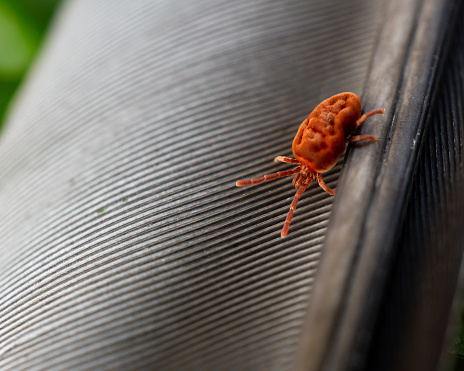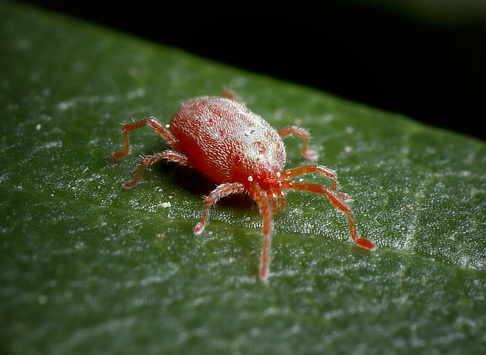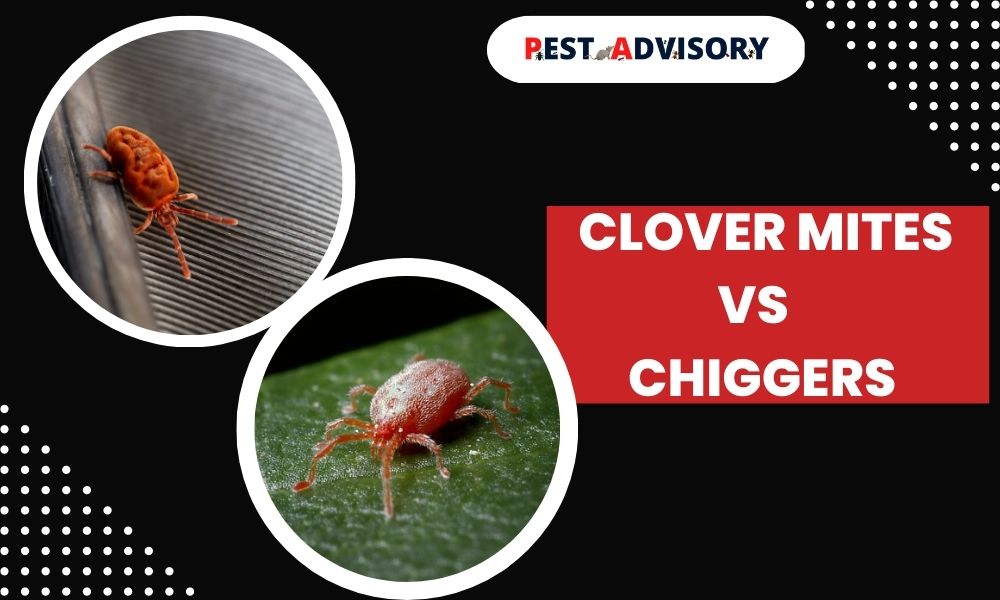It is very difficult to differentiate between bugs that are almost the same in size. The problem becomes even more difficult when they are tiny in size.
In this article, we are going to talk about the two bugs that follow the above conditions.
These are clover mites and chiggers. Both these bugs are very tiny and difficult to notice.
Important Note: If you're tired of pests and want a reliable solution, then you should definitely consider seeking help from a professional pest control company. DIY solutions can be effective, but if you're dealing with a significant pest infestation, you don't want to rely solely on DIY methods. Pest control companies typically don't charge huge fees. You can fill out this form to receive free quotes from the top local pest control companies, and compare the quotes and see for yourself. Then, finally, your pest problems will be eliminated for good.
We will differentiate them based on their appearance, feeding habits, life cycle, and hiding spots.
How Do Clover Mites and Chiggers Differ?
It is important to properly differentiate these bugs. To ensure this, we will look at the following factors to have a better understanding of these bugs.
Appearance
In North and South America, clover mites are often known as tiny red mites. They have 8 legs, in which the front ones are double the size of the others. These legs are sometimes mistaken as antennas as they are pointed toward the head.
The body is oval-shaped, with colors ranging from reddish to dark green. Their length is around 0.8mm.
On the other hand, chiggers are barely visible to the naked eye. These are noticed only when they are in a group with other chiggers. The number of legs changes with forms, the adult form has 8 while the juvenile form has 6 legs.
Chiggers are red-colored and are 0.95mm to 1.2mm long.
Eating Habits
Clover mites do not feed on blood. They take their nutrition from clover plants, grass, shrubs, trees, and other plants. You can find them on rooftops and patios due to the availability of mold and mildews to feed on.
Chiggers are very different in this aspect. They are bloodsuckers. They feed on the blood of animals, insects, and sometimes even humans. Small mammals, birds, and reptiles are ideal for them.
Chigger biting habits again differ based on their form. The adult form does not bite at all, it’s the chigger bugs at the larvae stage that bite humans. Their biting causes redness and itching and sometimes can even lead to an infection.
| Clover Mites | Chiggers | |
|---|---|---|
| Appearance | Small, red or green oval-shaped mites with eight legs | The tiny, red or orange, larval form of a type of mite |
| Size | About 0.8mm | About 0.95 to 1.2mm |
| Habitat | Found in the grass, clover, and other plants | Found in tall grasses, weeds, and brush, as well as in the soil and leaf litter |
| Geographic Range | Widely distributed in temperate regions | Found worldwide, particularly in warmer areas |
| Feeding Habits | Feed on plant sap | Parasitic, feed on the fluids of animals including humans |
| Bite Symptoms | Generally harmless to humans, may leave a red stain if crushed | Painful itching, red welts, or bumps, may cause a skin rash |
| Disease | Not known to transmit any diseases | Can transmit diseases like scrub typhus, tularemia, and others |
Life Cycle
The life cycle of clover mites begins with an unfertilized egg. The females are capable of laying up to 70 eggs, all of which are beneath barks of trees or cracks in walls.
After the hatching of eggs, next comes the larvae. The larvae feed by sucking the plant sap throughout their life. Adult clover mites live up to 2 weeks, while the whole generation survives for one month.
In the case of chiggers, they undergo a proper metamorphosis life cycle that comprises four stages: egg, larvae, nymph, and adult. The female chiggers lay up to 5 eggs that are kept in an area close to their source of food.
It takes around a week for the eggs to get hatched. Once they are hatched, next comes the larvae with six legs. It usually feeds on the skin tissues of warm-blooded hosts.
Larvae take around 10 days to get converted into a nymph and then within a month, they will become adults with 8 legs. The whole chigger life process usually takes anywhere between 2 months to 1 year.
Hiding Spots
Clover mites are mostly found in lawns under the bark of trees, on foundations, walls, and around window frames. They hide in these places as they mostly feed on green plants and trees, and all of these are found in the above-mentioned places.
Chiggers prefer moist grassy fields and forests. Warm and tropical regions with overgrown areas of pastures and grasslands are some of the places where chiggers are likely to be found.

Similarities between Clover Mites and Chiggers
Clover mites and chiggers are both small, red-colored insects that can be found in yards and gardens. Both insects feed on plant material and can cause damage to plants. However, there are some key differences between these two pests. Clover mites do not bite humans or animals, while chiggers can bite humans and animals, causing itching and irritation. Clover mites are also much larger than chiggers.
Prevention Tips to Avoid Infestations
As fall quickly approaches, so does the end of the mosquito and tick season. However, there are still a few pests that seem to be around all year long. Two of these pests are clover mites and chiggers. So, what is the difference between these two pests?
Clover mites are small, red spider-like creatures that feed on plant juices. They are often found in homes in late spring or early summer when they come inside looking for food. Clover mites do not bite humans or animals, but their presence can be a nuisance.
Chiggers are tiny red mites that feed on the blood of humans and animals. Chiggers are most active in late spring and early summer. They are often found in areas with high grass or weeds. Chiggers can cause intense itching and irritation. If you think you have been bitten by a chigger, it is important to seek medical attention as soon as possible.
There are a few things you can do to prevent infestations of clover mites and chiggers:
- Keep your lawn trimmed and free of debris.
- Seal cracks and crevices around your home to prevent entry from pests.
- Use a door sweep on all exterior doors to keep pests out.

How to Get Rid of Clover Mites and Chiggers?
To get rid of clover mites, all you have to do is focus on sealing cracks around windows, doors, and walls. When they are inside, you can use a vacuum cleaner and when they are outside you can use a miticide.
Since chiggers are very small in size, eliminating them is difficult. The best we can do is to apply a natural insect repellent lotion or spray whenever we go outside.
If you are going in areas where there are high bushes, try to cover your body as much as you can, and don’t forget to take a shower afterward.
Misconceptions about Clover Mites and Chiggers
There are a few common misconceptions about clover mites and chiggers. First, many people believe that clover mites are red insects. However, clover mites are actually very small arachnids that range in color from reddish-brown to dark brown. Second, some people think that clover mites bite. While they are capable of piercing skin, they do not actually feed on blood. Instead, they feed on plant sap and other organic matter. Finally, many people believe that chiggers are the same thing as clover mites. However, chiggers are actually a type of mite that feeds on the blood of animals (including humans).
Conclusion
On comparing chiggers vs clover mites, chiggers are more troublemakers. Since they are very small in size, they cannot be noticed properly. Due to this, eliminating them becomes difficult. At the same time, they are bloodsuckers, unlike mites.
Clover mites are just irritating bugs. They don’t pose any threats to humans and can be eliminated too. But this comparison doesn’t mean we can keep clover mites with us.
Both of these bugs have to be eliminated. Try out DIY treatments and if the number increases, opt for the pest control treatment.

